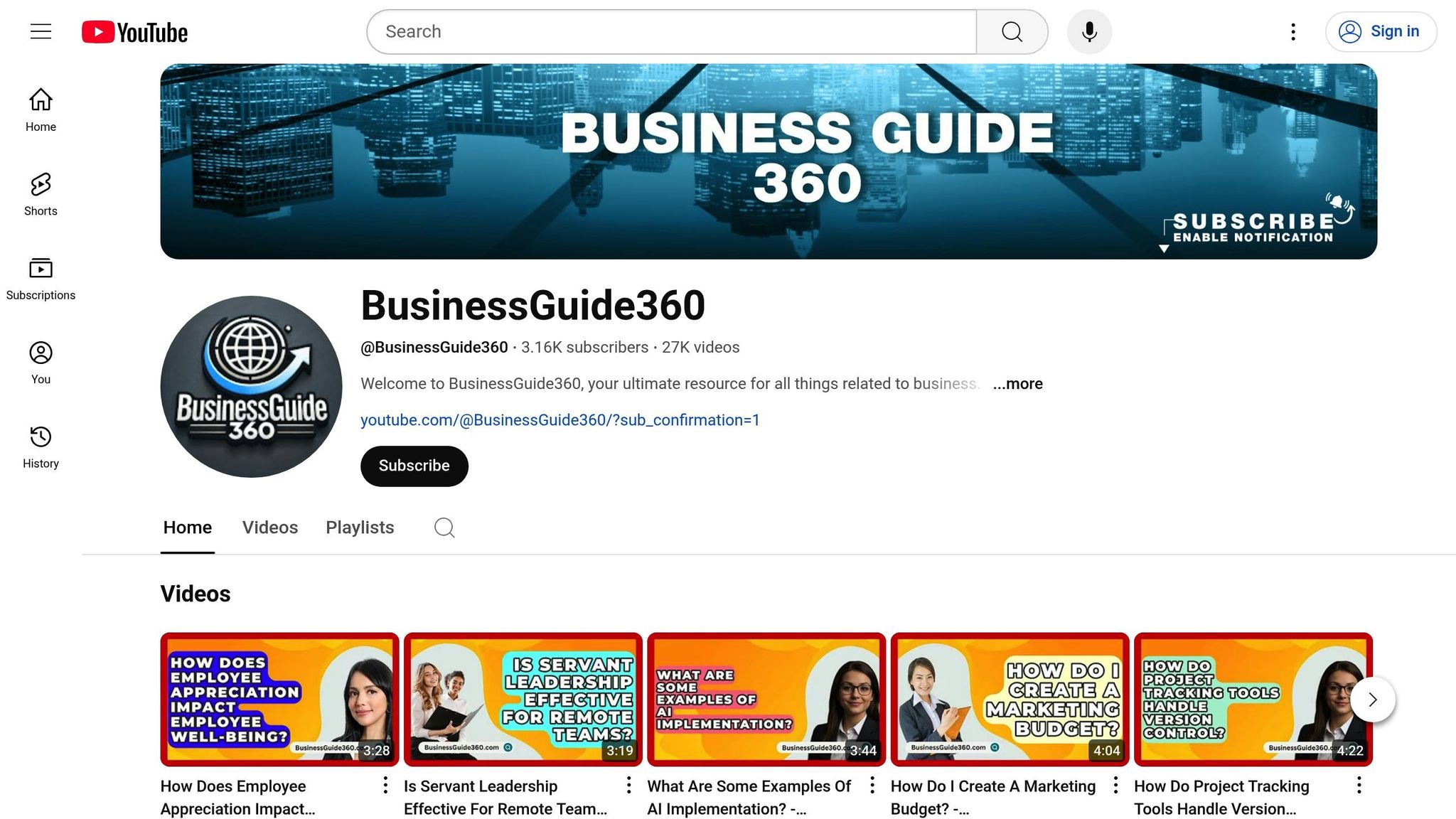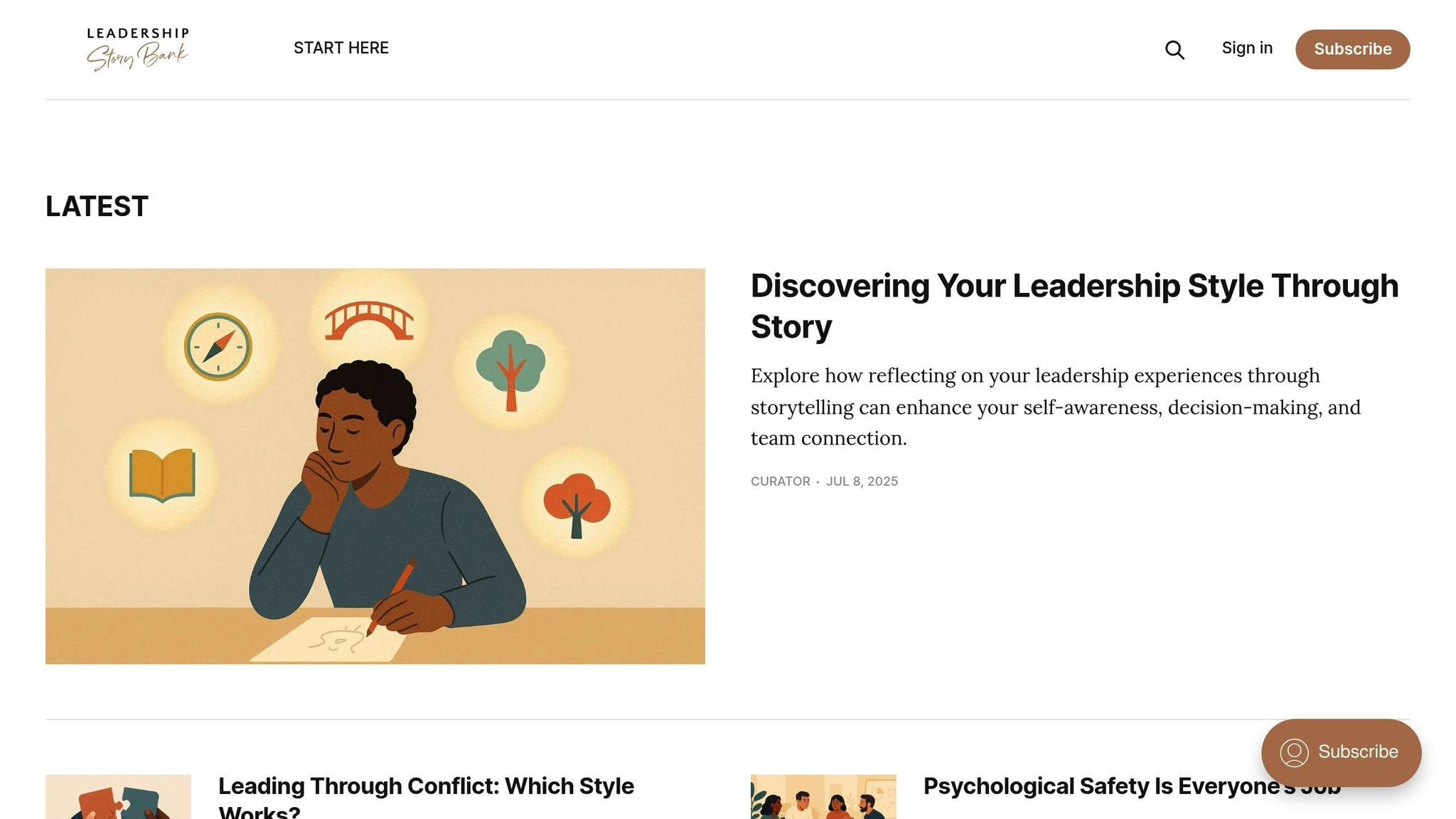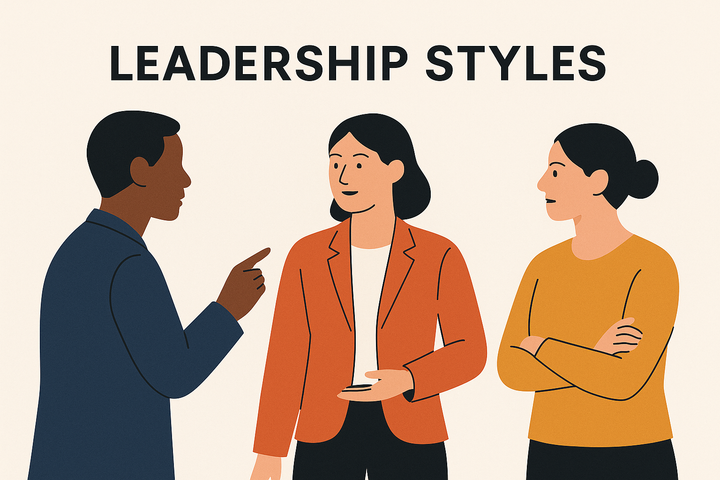How to Evolve Your Leadership Style Over Time
Explore how evolving your leadership style can enhance team performance and adapt to changing business landscapes through self-awareness and feedback.

Leadership isn't static. The way you lead today may not serve you - or your team - tomorrow. The business world moves quickly, and your ability to keep up depends on how well you adjust your leadership style. Here's the bottom line: great leaders constantly evaluate, refine, and adapt their approach to meet new challenges and opportunities.
Key Takeaways:
- Leadership evolves with context: The right style depends on the situation, your team, and organisational goals.
- Self-awareness is critical: Regular reflection helps you understand your strengths and areas for improvement.
- Feedback drives growth: Honest input from your team and peers is essential for refining your approach.
- Mistakes are lessons: Challenges and setbacks build resilience and offer valuable insights.
- Purpose and connection matter: Modern leaders align their values with their organisation’s vision and inspire their teams through meaningful communication.
By embracing these principles, you’ll not only grow as a leader but also create an environment where your team thrives. Let’s explore how to make this evolution a reality.
How Can a Leader Adapt Their Style to Different Situations? - BusinessGuide360.com

How Leadership Styles Develop
Leadership evolves through a mix of experience, learning, and deliberate effort. By understanding how leadership styles take shape, you can refine your approach to meet the demands of a dynamic business environment.
What Is a Leadership Style?
A leadership style reflects the methods, behaviours, and traits a leader uses to guide, motivate, and manage their team. It’s essentially your way of influencing and directing others, shaped by your personality, values, and the specific circumstances you face.
Your leadership style is a blend of how you give direction, your personal attributes, the context you operate in, and how you communicate. The way you combine these elements determines how effective you are as a leader.
"Leadership is inspiring, motivating, and guiding people to complete a goal." - Shubham R
Think of your leadership style as a toolkit. Some leaders focus on clear, structured instructions, while others prioritise empowering their team members. Neither approach is inherently better - it’s about finding the right fit for the situation and the individuals you're leading.
By understanding your leadership style, you gain clarity on how your approach impacts your team. This awareness highlights your strengths and pinpoints areas for improvement, forming the foundation for growth and adaptability.
How Leadership Theories Have Changed
The study of leadership has transformed significantly over the last century. With more than 32,000 academic papers and 4,500 books published on leadership topics during this time, our understanding of effective leadership has deepened.
Early theories often centred on the idea that leadership was rooted in fixed traits and personality characteristics, suggesting it was largely unchangeable. Modern theories, however, focus on flexibility, relationships, and ethical practices. They move away from rigid, one-size-fits-all approaches. Contingency theories, for example, argue that effective leadership depends on the specific context - there's no universal "best" style.
More recent concepts, such as complexity leadership, address the intricate challenges of today’s organisations. Leaders now recognise that effectiveness often requires drawing from a mix of theories and adapting their approach to suit the needs of their team and organisation.
"The evolution of leadership theory is the story of the gradual extension of the range of human attributes that are considered relevant to leadership." - James MacGregor Burns
This shift underscores that leadership development is a continuous journey rather than a fixed endpoint. Most leaders adjust their style based on the situation, a quality often referred to as "leadership agility".
Why Self-Reflection Matters
As leadership theories evolve, self-reflection becomes an essential tool for applying these insights in practice.
Self-reflection helps leaders understand their strengths and weaknesses, providing a clearer picture of how they lead. This awareness allows you to make intentional choices about your leadership approach rather than simply reacting to situations.
The benefits extend beyond personal growth. Regular reflection encourages ethical decision-making and helps leaders steer their organisations with purpose. By understanding your own motivations and biases, you can make decisions that benefit both your team and the broader organisation.
Self-reflection also encourages objectivity. By setting aside ego, leaders can assess situations more neutrally, enabling them to see the bigger picture and take effective action - especially during challenging times.
"Reflective leadership requires the continuous practice of reflection over time. This allows you to regularly examine and re-evaluate your decisions and responsibilities to practice, broaden, and deepen your skills, and to apply this knowledge when analysing present situations." - Nien-hê Hsieh, Harvard Business School Professor
Incorporating self-reflection into your routine doesn’t have to be time-consuming. Even dedicating 20 minutes a week can lead to meaningful insights. Experiment with methods like journaling, taking reflective walks, or reviewing your week at its start or end to find what suits you best.
During reflection, asking the right questions is key: What went well? What did I learn? What could I improve? Approach these questions without judgement, focusing on understanding rather than criticising yourself. Use your insights to plan specific actions, such as acquiring new skills or seeking mentorship.
Reflective leadership not only fosters personal growth but also strengthens relationships within your team. It creates an environment built on ethics and accountability, helping you support your team members in developing their own leadership potential.
These practices lay the groundwork for understanding what drives ongoing leadership growth.
What Drives Leadership Growth
Leadership growth is shaped by several key factors, each playing a role in how leadership styles evolve over time. By understanding these elements, leaders can take an active role in their development instead of leaving it to chance.
Using Feedback to Improve
Feedback is a powerful tool for growth, offering insights into both your strengths and areas that need attention. Without regular and honest feedback, it’s easy to overlook how your actions affect others. Taking the initiative to seek feedback - through regular check-ins with team members and peers - shows your dedication not only to your own improvement but also to the development of those around you.
When receiving feedback, it’s crucial to listen attentively and ask questions to fully understand the concerns being raised. Use this information to reflect on how it aligns with your goals, and then create clear action plans to address any gaps. A workplace culture that encourages open feedback amplifies these benefits, fostering mutual growth and understanding.
Feedback is only part of the equation. How you respond to challenges and setbacks also plays a major role in shaping your leadership style.
Learning from Mistakes and Challenges
Mistakes, while often uncomfortable, are invaluable for growth. They highlight areas for improvement, build resilience, and encourage a reassessment of strategies. Each challenge you face strengthens your ability to navigate future obstacles and fosters empathy, making you better equipped to support your team. Taking the time to reflect on what went wrong can uncover important lessons, while practising self-compassion helps maintain a healthy balance.
"Failure is simply the opportunity to begin again; this time more intelligently." – Henry Ford
"The only bad lesson is the one never learned." – Darrick Weeks' Grandfather
Leadership often involves taking risks, and embracing mistakes as learning opportunities creates a safe space for experimentation. This approach not only encourages innovation but also reduces the fear of failure within your team.
Building on What Works
While feedback and challenges are crucial, recognising and building on your successes is just as important. Success provides a foundation for refining effective strategies and exploring new ideas. Mentorship and coaching programmes can play a key role here, helping to share best practices and strengthen leadership across the organisation.
"Mentorship is a cornerstone for nurturing the skills and mindsets necessary for leadership excellence, including a growth mindset, communication, resilience, and innovation." – River Software
Leadership training, whether through workshops, seminars, or courses, supports this process by refining existing skills and encouraging collaboration. Drawing on past successes to inform strategic communication can empower teams and create a culture of continuous learning. At the same time, prioritising self-care sends a clear message: effective leadership starts with maintaining your own well-being.
"Cultivating an organisational value of collaboration and co-creation not only enhances team dynamics but also drives innovation." – River Software
"By prioritising self-care, leaders can sustain their performance and inspire their teams to achieve greater heights." – River Software
Together, these factors - leveraging feedback, learning from challenges, and building on successes - create a cycle of growth and refinement. This balanced approach ensures leaders can adapt and thrive in an ever-changing environment.
How to Develop Your Leadership Style
Developing your leadership style isn't something that happens overnight. It requires a thoughtful, step-by-step approach. The best leaders take the time to evaluate their abilities, set clear goals, and measure their progress along the way.
The ADAPT Framework
The ADAPT Framework offers a structured path to leadership growth, breaking the process into five clear stages. It encourages ongoing self-assessment and adjustment throughout your leadership journey.
| Stage | Description | Key Activities |
|---|---|---|
| Assess | Evaluate current situation | Interviews, assessments, 360-degree feedback |
| Develop | Create action plan | Goal setting, strategy formulation |
| Act | Implement the plan | Skill development, behaviour change |
| Progress | Monitor and adjust | Regular check-ins, performance tracking |
| Transition | Ensure sustainable change | Long-term planning, self-coaching skills |
Start by assessing your current leadership style. Use tools like 360-degree feedback, self-assessments, and structured interviews to pinpoint your strengths and areas that need improvement.
Next, develop a plan with SMART goals that align with your leadership aspirations. These goals should address the areas you want to improve, ensuring your efforts are focused and measurable.
Once your plan is in place, act by adopting new behaviours and improving key skills. This stage often pushes you out of your comfort zone, prioritising hands-on learning over theory.
As you move forward, monitor your progress through regular check-ins and performance reviews. Use these moments to evaluate what’s working and tweak your approach if necessary.
Finally, transition by embedding your new habits into your daily routine. Self-coaching and long-term planning will help make these changes stick, ensuring your leadership style continues to evolve alongside your organisation's needs.
Matching Your Style to Your Organisation
Your leadership style should not only reflect who you are but also align with your organisation's goals and values. This alignment builds trust and enhances your effectiveness. Start by gaining a clear understanding of your organisation’s vision and values, as these will serve as the foundation for your leadership alignment.
Harvard Business School Professor Joshua Margolis highlights this connection:
"Leading at scale and scope requires you to treat communication as a tool to reach out to people, captivate heads, and move hearts, so those you're leading understand your actions and goals, and, perhaps more importantly, so they understand where they fit and why their work matters."
Open communication is key to building trust and aligning objectives. Take IBM as an example. When faced with rapid technological changes, the company pivoted towards innovation and agility. By engaging employees through open dialogue, encouraging their input, and implementing gradual cultural shifts, IBM successfully adapted to the digital age.
Tools like collaboration platforms and project management software can also help leaders stay connected to their teams and the organisation’s broader strategic goals. These tools ensure decisions are well-informed and aligned with the overall vision.
Using Leadership Story Bank Resources

To further refine your leadership approach, consider using storytelling as a tool. Storytelling can clarify your vision, strengthen team connections, and make complex ideas more relatable. According to Leadership Story Bank research:
"Effective storytelling transforms leadership communication, making complex ideas relatable and inspiring action through emotional connections."
Storytelling has long been a way for humans to connect, make sense of the world, and share their identity - a crucial skill for leaders.
The Storytelling Leader programme is designed to help leaders and teams articulate their purpose and values. It provides practical tools like:
- Story Dash Cards: Useful for guiding transformation efforts.
- The Story Canvas: A framework for crafting impactful narratives.
- The Leadership Story Deck: Helps uncover stories tied to outcomes such as innovation, sales, or strategy.
One senior vice president of sales from a Fortune 500 pharmaceutical company shared:
"The Storytelling Leader is the most powerful leadership programme I've attended. Now I'm using stories to create a richer dialogue with my markets… and even with my family at the dinner table."
These storytelling tools complement the ADAPT Framework, offering practical ways to implement and refine your leadership style. By weaving storytelling into your approach, you can communicate more effectively and build stronger connections with your team.
Current Trends in Leadership Development
As leadership continues to evolve, modern leaders are being called to meet new challenges and expectations. Teams and stakeholders alike now demand more than just results; they seek leaders who can adapt, inspire, and connect on deeper levels. By understanding these emerging trends, you can refine your leadership approach to stay effective and relevant in today’s increasingly complex business landscape.
Purpose-Driven Leadership
For many employees, work is no longer just about earning a paycheque. A striking 70% of employees link their sense of purpose to their job. This shift has made purpose-driven leadership a cornerstone of modern organisations. Unlike traditional leadership, which often focuses on profit alone, this approach aligns personal values with organisational goals, creating a sense of shared meaning.
Purpose-driven leadership is about helping employees find personal fulfilment in their roles while fostering a committed and motivated workforce. The benefits are clear: organisations that embrace this style report 30% higher innovation levels and 40% better retention rates.
Here are some key traits of purpose-driven leaders:
| Characteristic | Description |
|---|---|
| Clarity of Purpose | Clearly communicates the organisation's purpose |
| Empathy and Compassion | Understands and supports team members |
| Integrity and Ethical Behaviour | Upholds strong moral principles |
| Impact-Oriented | Aims to create a positive difference in the world |
| Strategic Thinking | Develops a clear vision and actionable strategies |
To integrate purpose-driven principles into your leadership, start by embedding your organisation’s mission and values into everyday conversations. Take the time to understand what motivates your team members - show genuine care for their aspirations and challenges.
"Before you can lead others with purpose, you need to articulate what drives you to be your best every day." – Katelynn Blackburn, founder of Diligence Agencies
Define a compelling vision that connects daily tasks to broader, meaningful outcomes. Lead by example - live the values you wish to see in your team. Above all, make purpose a central part of your organisation’s strategy rather than treating it as an afterthought.
Digital Leadership
The digital era has transformed the way leaders operate. With the global Digital Transformation Market projected to grow from USD 695.5 billion in 2023 to USD 3,144.9 billion by 2030, the need for leaders who can navigate this landscape is greater than ever. Yet, despite this growth, only 30% of companies successfully manage digital transformation.
Digital leadership involves guiding organisations through change by leveraging technology and data effectively. This requires a mix of business acumen and technological know-how. Leaders in this space must embrace data-driven decision-making and work to close digital skills gaps, which 77% of companies identify as a major challenge.
To build your digital leadership skills:
✓ Invest in continuous learning - take online courses or attend workshops on emerging technologies.
✓ Familiarise yourself with industry-specific tools and platforms.
✓ Develop strong communication skills for virtual and hybrid work environments.
✓ Enhance your ability to analyse and interpret data for informed decision-making.
Additionally, mentoring your team to develop their own digital skills can help create a culture where technological adaptation becomes a shared responsibility, rather than a top-down directive.
Collaborative Leadership
As workplaces evolve, so too does the concept of authority. Collaborative leadership focuses on shared decision-making and collective problem-solving. This approach values diverse perspectives, fosters psychological safety, and encourages innovation. Leaders who embrace collaboration understand that every team member has something meaningful to contribute.
The foundation of collaborative leadership lies in trust and transparency. Instead of relying on control, collaborative leaders use influence and thoughtful questioning to guide their teams towards creative solutions. Companies like Marriott, Pixar, and the BBC have successfully implemented this approach by promoting cross-functional teamwork, building a sense of community, and maintaining flexibility while ensuring clear roles and responsibilities.
To adopt a collaborative leadership style:
• Set clear, measurable team goals.
• Encourage open communication through regular meetings, open-door policies, and anonymous feedback options.
• Promote diversity and inclusion by addressing biases and creating equitable processes.
• Delegate strategically and organise team-building activities to strengthen connections.
• Recognise both individual and team achievements, providing constructive feedback along the way.
Continuous professional development is also key - invest in training that supports learning and skill growth for both yourself and your team. Be prepared to adjust your strategies based on feedback and changing circumstances. Collaboration takes time and patience, but the rewards are well worth the effort. Over time, teams will learn to work together more efficiently and effectively.
Conclusion: Making Leadership Growth a Continuous Process
Becoming a better leader is not a destination - it’s an ongoing journey that demands dedication, curiosity, and the courage to evolve. The most impactful leaders understand that their approach must grow and adapt to keep pace with their teams, organisations, and the ever-changing business world. This willingness to evolve is what sets apart good leaders from those who leave a lasting mark.
At the heart of continuous leadership growth lies self-awareness and feedback. Research highlights the importance of feedback: employees who receive it from their managers are nine times more likely to trust them. Additionally, 80% of employees who’ve had meaningful feedback in the past week report being fully engaged at work. Seeking feedback - and acting on it - not only builds trust but also fuels personal and professional development.
Once equipped with greater self-awareness and constructive feedback, the next step is to refine your leadership approach. Pay attention to signs that adjustments are needed, such as declining team morale or missed deadlines. When these signals appear, it’s time to reassess, reset your mindset, and choose a leadership style that fits your team’s current needs.
The ability to view change as an opportunity rather than a threat is a hallmark of great leadership. Leaders who embrace adaptability create a culture of ongoing improvement, enabling their teams to navigate uncertainty with confidence. Your response to change sets the tone for your team - leading with resilience and positivity encourages others to follow suit.
Your team is always observing how you handle challenges and growth. By seeking feedback openly and taking bold steps to improve, you demonstrate vulnerability and courage. This not only strengthens trust but also inspires your team to adopt a similar mindset. Over time, this approach embeds a culture of continuous improvement into your organisation, transforming it from a one-off initiative into a core value.
The key to growth is action. Start small: ask a team member for feedback today or reflect on a recent challenge to find a better way forward. These small but consistent efforts will build momentum, leading to meaningful leadership growth over time.
Leadership is a lifelong evolution. Embrace it as a strength, not a limitation. The leaders who leave the greatest legacies are those who never stop learning, adapting, and growing - alongside the people they serve.
FAQs
How can I determine the best leadership style for my team and organisation?
To determine the best leadership style for your team and organisation, start by examining how your approach influences morale, collaboration, and productivity. Take note of how team interactions and results shift when you adjust your leadership style in various situations.
Encourage open and honest feedback from your team to gain insight into their preferences and needs. Keep in mind elements like individual personalities, the workplace culture, and the organisation's broader objectives. A successful leadership style is one that builds engagement, trust, and efficiency, enabling both your team and the organisation to flourish.
How can I use self-reflection to improve my leadership skills over time?
To weave self-reflection into your journey as a leader, begin by carving out dedicated time to evaluate your actions, decisions, and their results. A journal can be a valuable tool for noting patterns, tracking progress, and identifying areas that need attention. Using structured methods, such as Gibbs' Reflective Cycle, can provide a clear framework to help you learn from both achievements and challenges. From these reflections, set specific, practical goals to fine-tune your leadership style and keep growing.
How can storytelling help me grow as a leader and improve communication within my team?
Storytelling holds a special place in leadership, acting as a bridge that connects you with your team on a more personal and emotional level. By sharing experiences or lessons that others can relate to, you breathe life into your vision and values, making them feel real and attainable.
Stories also bring clarity and build trust. They simplify complex ideas, making them easier to grasp and, crucially, more memorable. When woven into your leadership approach, storytelling has the power to unite your team, fostering a shared sense of purpose while encouraging open and honest communication. It’s a way to lead that not only guides but genuinely resonates.



